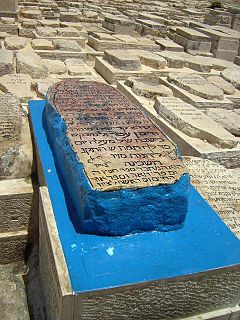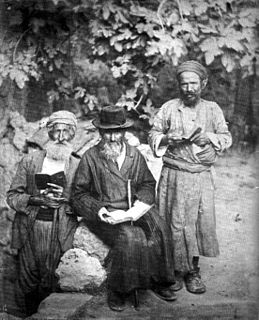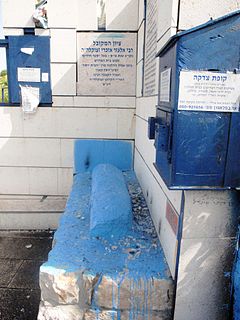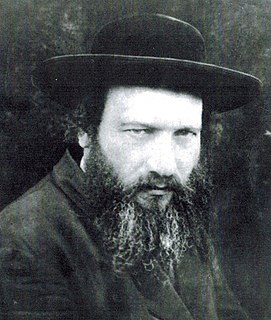Related Research Articles
Yom Tov ben Moshe Tzahalon,, also known as the Maharitz,, was a student of Moses di Trani and Moshe Alshich, and published a collection of responsa.
Israel ben Moses Najara was a prolific Jewish liturgical poet, preacher, Biblical commentator, kabbalist, and rabbi of Gaza.

Rabbi Moses Isserles, also known by the acronym Rema, was an eminent Polish Ashkenazic rabbi, talmudist, and posek.
Hayyim ben Joseph Vital was a rabbi in Safed and the foremost disciple of Isaac Luria. He recorded much of his master's teachings. After Vital's death, his writings began to spread and led to a "powerful impact on various circles throughout the Jewish world."

Moshe Alshich Hebrew: משה אלשיך, also spelled Alshech, (1508–1593), known as the Alshich Hakadosh , was a prominent rabbi, preacher, and biblical commentator in the latter part of the sixteenth century.

Yaakov ben Moshe Levi Moelin was a Talmudist and posek best known for his codification of the customs (minhagim) of the German Jews. He is also known as Maharil - the Hebrew acronym for "Our Teacher, the Rabbi, Yaakov Levi" - as well as Mahari Segal or Mahari Moelin. Maharil's Minhagim was a source of law for Moses Isserles’ component of the Shulkhan Arukh.

Chaim ibn Attar or Ḥayyim ben Moshe ibn Attar also known as the Or ha-Ḥayyim after his popular commentary on the Torah, was a Talmudist and Kabbalist. He is arguably considered to be one of the most prominent Rabbis of Morocco, and is highly regarded in Hassidic Judaism.
Demai (Hebrew: דְּמַאי, is the third tractate of Seder Zeraim of the Mishnah and of the Talmud. It deals with the Jewish legal concept of demai, meaning doubtfully tithed produce, and concerns the laws related to agricultural produce about which it is suspected that certain obligatory tithes have not been separated in accordance with requirements derived from the Torah.

David ben Solomon ibn (Abi) Zimra (1479–1573) also called Radbaz (רַדְבָּ"ז) after the initials of his name, Rabbi David iBn Zimra, was an early Acharon of the fifteenth and sixteenth centuries who was a leading posek, rosh yeshiva, chief rabbi, and author of more than 3,000 responsa as well as several scholarly works.
Yedid Nefesh is the title of a piyyut and zemer. It is usually sung on Shabbat.
Modeh Ani is a Jewish prayer that observant Jews recite daily upon waking, while still in bed.
Shem Tov ben Abraham ibn Gaon was a Spanish Talmudist and kabbalist.
Moshe ibn Habib was the Rishon LeZion, Hakham Bashi and the head of a major yeshiva in Jerusalem.
Moshe ben Mordechai Galante(Hebrew: משה בן מרדכי גאלאנטי), was a 16th-century rabbi. He was a disciple of Joseph Caro, and was ordained by Caro when he was only twenty-two years old. He wrote sermons for a wedding, for Passover, and for a thanksgiving service, printed with the younger Obadiah Bertinoro's commentary on the Book of Esther. He also wrote Miftaḥ ha-Zohar, an index of Biblical passages found in the Zohar and additions from old manuscripts, Kehillat Ya'aḳob, a cabalistic commentary on Ecclesiastes, and responsa with additions by his son Jedidiah Galante.

Shabbat is the first tractate of Seder Moed of the Mishnah and of the Talmud. The tractate deals with the laws and practices regarding observing the Jewish Sabbath. The tractate focuses primarily on the categories and types of activities prohibited on the Sabbath according to interpretations of many verses in the Torah, notably Exodus 20:9–10 and Deut. 5:13–14.

Rabbi Elazar ben Moshe Azikri (1533–1600) was a Jewish kabbalist, poet and writer.
Moshe ben Avraham Provençal (1503–1576) was an Italian posek, Hebrew grammarian, and mathematician.
Moses ben Mordecai Bassola or simply Moses Bassola, alternative spelling: Moshe Basola, Basilea, Basila ; born 1480, in Pesaro, Italy - died in 1560 ) was a rabbi and a cabalist. His travel book has been published in English and modern Hebrew by Abraham David under the titles In Zion and Jerusalem: The Itinerary of Rabbi Moses Basola (1521–1523)
Judah ben Yakar was a rabbi and talmudist.

Ya'akov Yechezkiya Greenwald was the rabbi of the Etz Chaim community in Pápa, Hungary, and the rosh yeshiva there. He was the predecessor of the Pupa Hasidic dynasty.